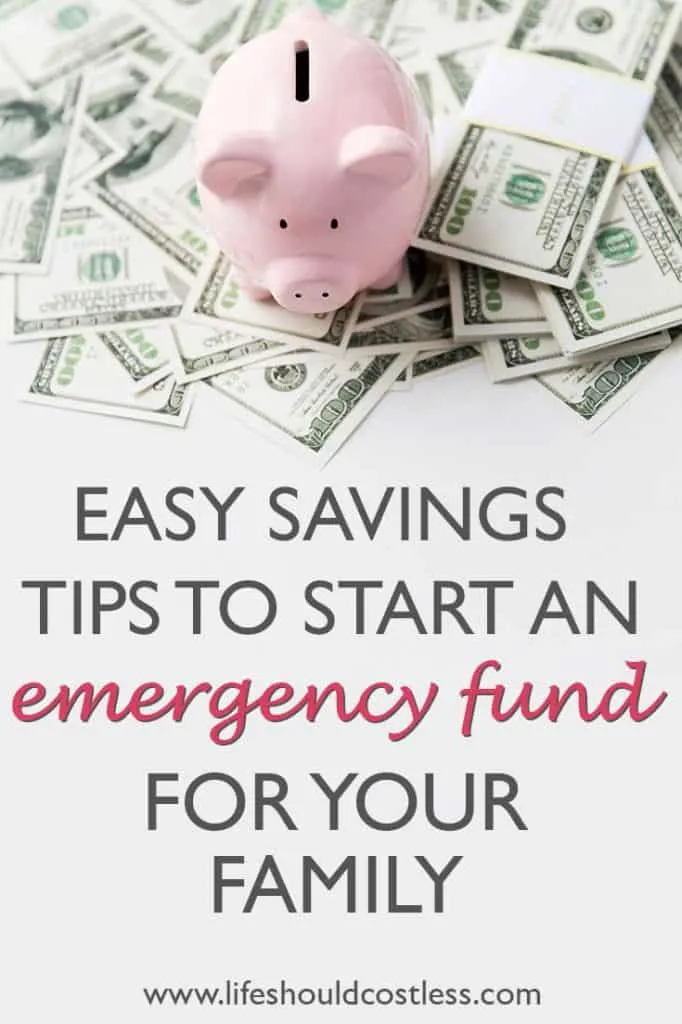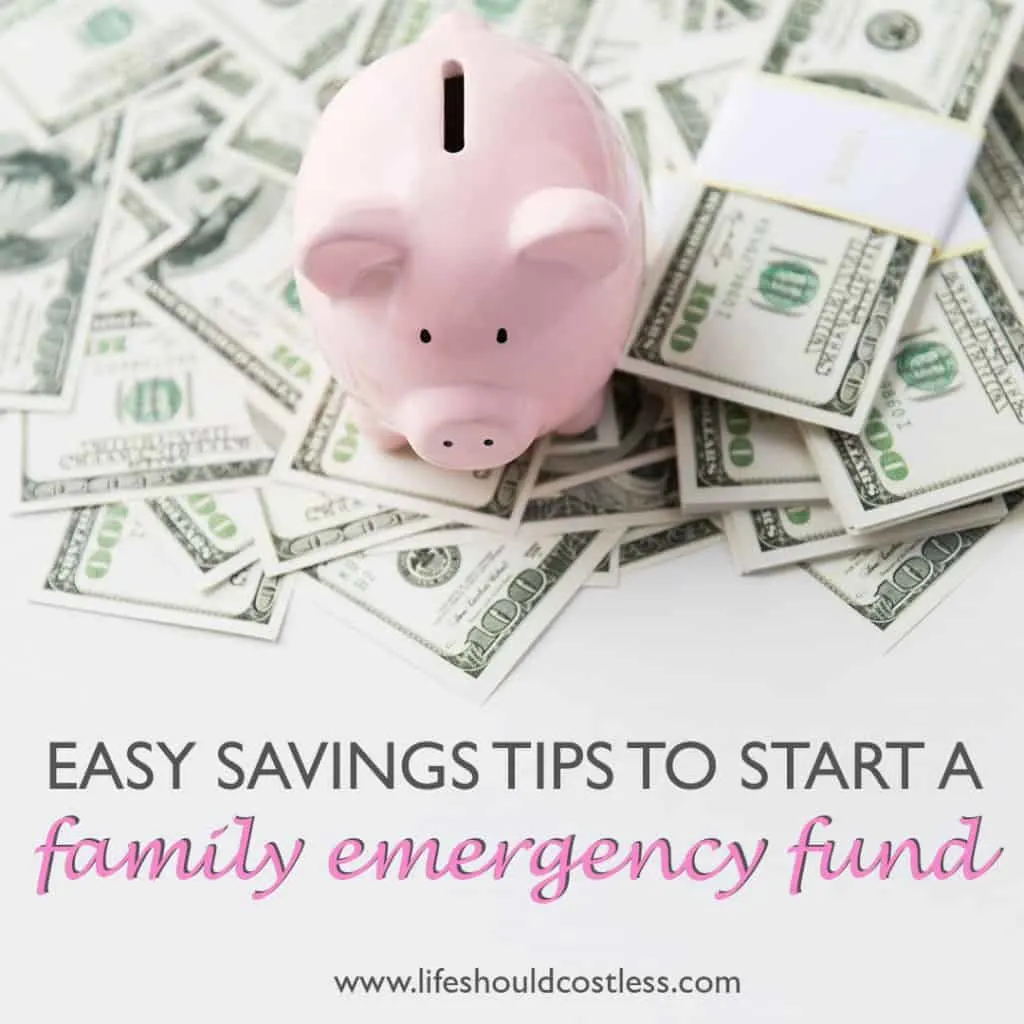Whether you think that things are too tight to have an emergency savings or not, it is one of the single most important things you can do to plan for the unexpected. Here are a few savings tips that are easy ideas to get some reserves set aside & give yourself, & your entire family, some financial piece of mind.

Now more than ever, having an emergency fund is essential – especially when you have a family. This special fund is dedicated only to emergency expenses.
So the next time your roof starts leaking or your car won’t start, your family won’t have to scrape together (or panic) extra money to pay for it.
With so many possible reasons to have a financial cushion, creating an emergency fund for your family as soon as possible is critical.
Though finding ways to set aside extra money for an emergency fund can be difficult if you don’t know where to start. These easy savings tips are some of the best ways to save and create a family emergency fund.
Make a Budget
If your family doesn’t have a budget in place, this is one of the best savings tips I can give you. A budget will not only help your family see exactly where your money is going, but it will also help you identify places where you can save money throughout the month.
Take the time to sit down and map out all your family’s income and expenses. Break those expenses into different categories based on the types of expenses your family has.
Then create a monthly budget by allocating a portion of your income to each expense category.
If you see you have more money going out than you do coming in, it’s time to adjust your spending to make your expenses match your income.
After that, you can find more ways to cut back on your spending to set aside money for creating an emergency fund and paying down your debt.
Finding simple ways to cut your budget is one of the best ways to start an emergency fund. As you adjust your spending habits to align with your monthly budget, you will be able to find even more ways to save and increase the amount of money you set aside for savings each month.
Emergency Fund Savings Tips
Finding ways to slash your budget may seem like a big task. Instead of looking for large portions of your budget to cut, consider finding smaller ways to save every month.
There are several little steps each month you can take to cut down on your overall spending. There easy savings tips are great ways to spend less and save more every month:
- Cut back on nonessential bills, like cable, to reduce your regular monthly expenses.
- Negotiate new rates on essential bills, like your insurance and cell phone, to save a little extra each month.
- Stick to your grocery list to avoid impulse purchases and cut back on your food expenses.
- Stay in on the weekends instead of splurging on eating out or spending extra money on entertainment.
- Find free activities for your family to enjoy together, like playing at the park or going on a bike ride, instead of paying for expensive entertainment.
- Drink water instead of soda or coffee to reduce your bill when you eat out, as well as cut back on your monthly grocery expenses.
- Cook your meals at home and avoid eating out, buying lunch while you’re at work, or hitting the drive-through on your way home.
- Use a programmable thermostat to cut back on your heating and cooling costs…remember that fans help to cut cooling costs, and don’t be above just opening the windows.
- Swap out traditional light bulbs for LED lights that use less energy. Also, make sure your lights are off when you’re not in a room to reduce your electricity bill each month. You can train your family and start charging them a quarter whenever they leave a light on in a room after leaving it…you think I’m joking, but it totally works.
- Shop at resale shops and yard sales instead of purchasing new clothing, toys, and home décor.
- Find ways to make a little extra income by holding a yard sale or starting a new side hustle.
- Always comparison shop before making a purchase so you know you’re getting the best deal…don’t just buy the thing you want right that second.
- Take a look at all your subscriptions and services and cancel everything you don’t absolutely need.
- Keep your finances, payments, and bills organized to avoid missed or late payment fees.
- Learn basic DIY skills to tackle household problems on your own instead of being forced to hire a costly repairman…Youtube is your friend.
- Stop using paper products (paper towels, plates, cups, napkins, etc.) and use reusable products instead.
- Try a generic version of some of your usual products to cut back on the amount of money you spend on groceries.
- Shop your pantry and freezer before heading to the grocery store to avoid purchasing items you don’t need. Meal planning is smart to save money too.
- Take advantage of all the free things your library has to offer, from free reading material to fun family activities.
Set a Goal
The best way to measure your success and keep track of your savings is to set a goal for yourself. Most emergency fund goals should be set to cover between three and six months of expenses.
While the fund may be used for emergency expenses, it’s also a good idea to have this cushion available for your family in case someone loses their job or are unable to work.
To calculate how much money your family will need for three to six months, add up all your essential expenses (mortgage or rent, utilities, food, and transportation expenses) and multiply it by the number of months you want to save for.
Start small by setting a goal of one month of expenses, then increase it to three, six, or even one year.
Make Your Progress Visible
To keep you motivated to achieve your savings goals, make your progress visible by hanging a progress bar on your refrigerator or somewhere that you will look at it often.
Each time you add to your emergency fund, fill in the bar to remind yourself how much you have saved and how far you have left to go.
This small reminder may make it a little bit easier to cut back on your spending each month to help you increase your savings and achieve your goal more quickly.
Make it Automatic
After you have a budget in place, it’s time to start finding ways to save a little bit of extra money each month to put toward an emergency fund.
One of my favorite savings tips is to place your savings into an account before you even have a chance to spend it. Set an automatic transfer from your checking account to your savings account on each payday.
The second your paycheck goes into your account, the money set aside for savings will move from one account to the other.
That way, you won’t have a chance to spend the money before it gets allocated to your emergency fund.
Keep Increasing Your Savings
When you’re first starting out saving money in an emergency fund, your monthly deposits into your savings account will probably be small.
After you’ve grown accustomed to setting aside savings each month, start gradually increasing the amount of money you save.
Make it a habit to adjust your budget every few months to see where you can cut back your spending or find ways to increase your income to add more to your emergency savings.
Don’t Stop Saving
Once you have reached your emergency savings goal, I suggest a years worth of expenses, don’t stop! Continue adding to your savings account to give your family even more of a financial cushion.
Or consider moving additional savings to a long-term savings plan like a CD or money market account to get a bigger return on your investment.
Then of course, the next step is paying off debt for even more financial freedom.
That’s really all I have to share with you all today. Hopefully it got your financially fit juices flowing to help give you some ideas to start saving.
Thanks so much for stopping by my blog! If you liked what I shared please make sure to spread the love on social media. Thanks again! ~Sarah

How To Follow & Support This Site
- If you would like to subscribe to my email list, go here.
- Make sure to follow along via social media, by going here.
- If you would like to learn how to really show your support to this site (at no cost to you), go here.
- If you would like to make a direct donation to the site, go here.
P.S. You may want to check out my entire “Money” Section…anything and everything that I write about to save money goes into that category.
Here are a few of my other financial advice posts that you’re probably going to like too:

